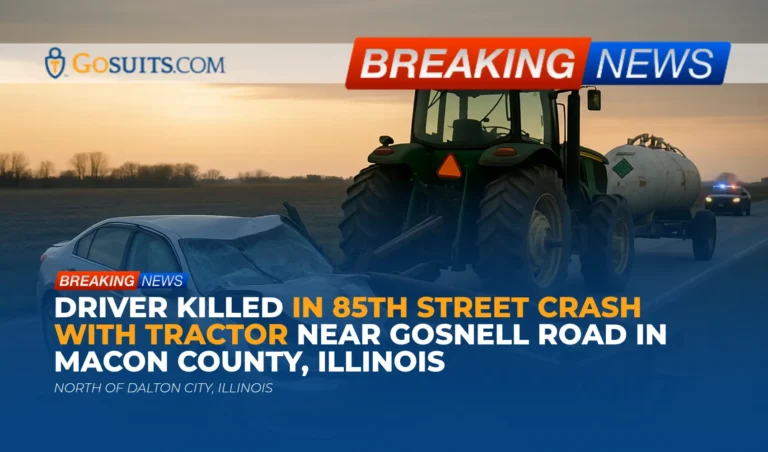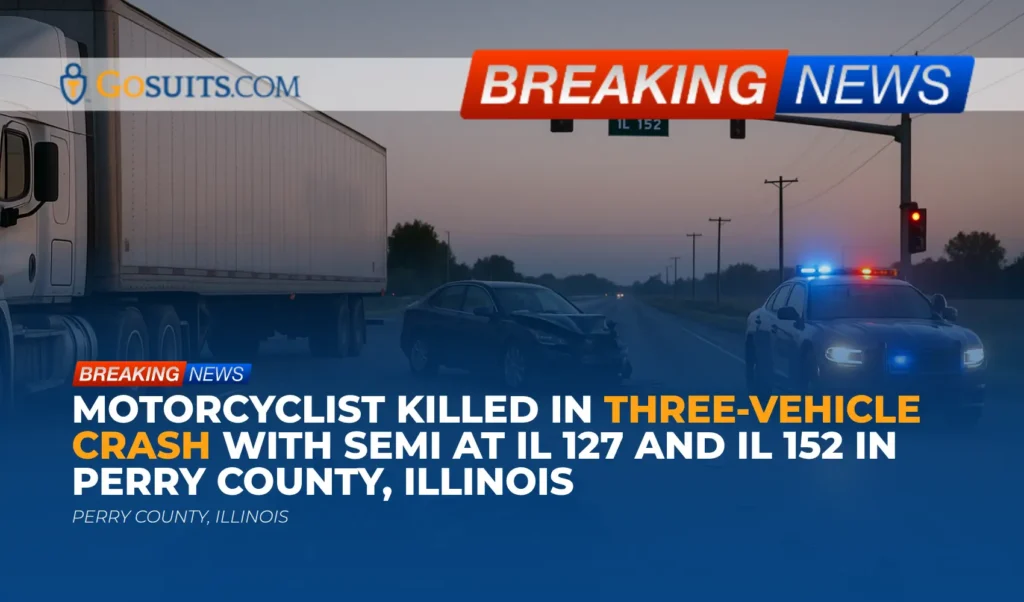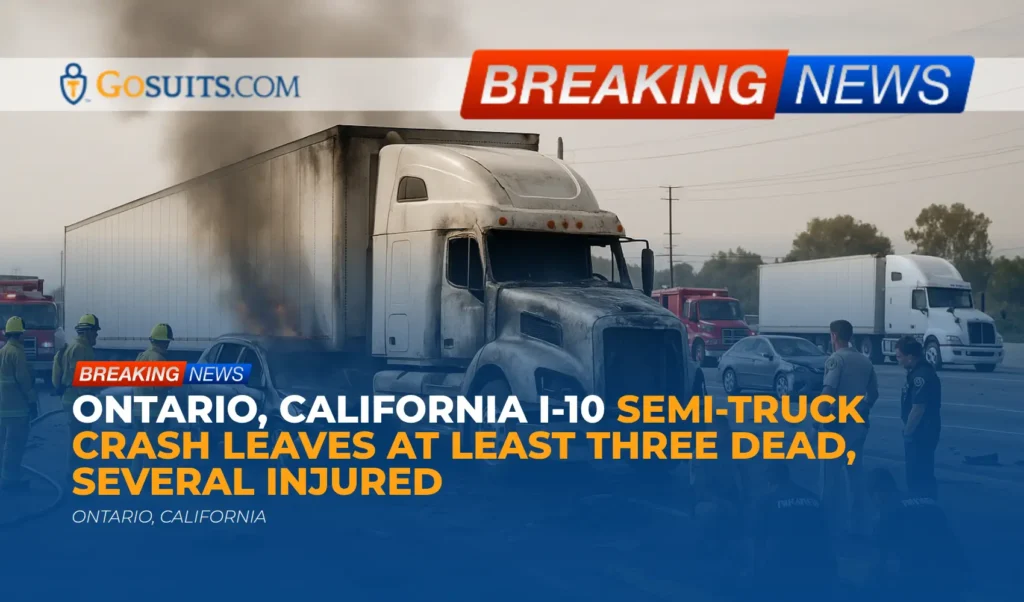- What happened on 85th Street near Gosnell Road
- Location, timing, and responding agencies
- Vehicles and equipment involved
- Safety context during Illinois harvest season
- Illinois traffic laws relevant to this crash
- Understanding anhydrous ammonia tanks in road incidents
- How families can obtain official records and assistance
- Insurance and claims overview after a rural road fatality
- Practical steps for documentation and safety
- Community safety takeaways for drivers and farmers
- Commentary from Gosuits Dalton City, Illinois Personal Injury Attorney
- Time-sensitive next steps
What happened on 85th Street near Gosnell Road
According to the Macon County Sheriff’s Office, a deadly collision occurred on Thursday on 85th Street near Gosnell Road, just north of Dalton City, Illinois. A tractor towing an anhydrous tank was traveling southbound. A northbound vehicle driven by a 51-year-old man from Tuscola collided with the tractor’s extended anhydrous applicator. The driver of the northbound vehicle was pronounced deceased at the scene. Authorities reported that the anhydrous tanks were intact and there were no hazardous conditions. The tractor operator was cited for improper lane usage, and officials indicated that additional charges could be considered pending further investigation. The Sheriff’s Office asked motorists to use extra caution on rural roads during harvest season, where lighting conditions and colder weather can reduce visibility and increase risks.
These are the facts as reported by local law enforcement at this stage. Investigations typically continue for weeks as agencies review scene measurements, equipment condition, lighting, roadway geometry, and other potential contributing factors.
Location, timing, and responding agencies
The crash took place north of Dalton City in rural Macon County, Illinois, on 85th Street near Gosnell Road. The Macon County Sheriff’s Office responded and is leading the investigation. The Macon County State’s Attorney may review the case for potential charges after law enforcement completes its investigation.
Rural roadway crashes can be complex because farm equipment frequently shares the road with passenger vehicles, especially during planting and harvest seasons. Environmental conditions such as dusk and dawn lighting, fog, and colder temperatures can also play a role.
Vehicles and equipment involved
The vehicles involved included a passenger vehicle traveling northbound and an agricultural tractor towing an anhydrous tank with an extended anhydrous applicator. An anhydrous applicator can extend from the width of the tractor into the lane area, and this extension is a critical factor for visibility, lane placement, and safe passing or meeting oncoming traffic. In this incident, the collision involved the tractor’s extended applicator rather than a direct contact with the tractor body or the tank itself. Authorities confirmed the anhydrous tanks remained intact.
Assessing these collisions often involves examining the positioning and visibility of the farm equipment, including whether slow-moving vehicle emblems and lighting were properly displayed, whether the equipment was within permitted width or appropriately using the lane, and whether the roadway lanes permitted safe travel by both vehicles.
Safety context during Illinois harvest season
Rural roadway fatalities remain a significant public safety concern. National crash data show that rural roads account for a disproportionately high share of fatal crashes compared to urban areas. NHTSA’s rural and urban comparisons indicate that nearly half of U.S. traffic fatalities occur on rural roads each year, despite a smaller share of the population living in rural areas. See NHTSA’s rural versus urban traffic safety data for context at NHTSA Crash Stats.
Harvest season increases traffic by slow-moving agricultural equipment on two-lane roads. Reduced daylight hours, early morning and late afternoon glare, and variable weather can all lower visibility. Farm machinery travels at much lower speeds and can extend beyond a single travel lane. These factors demand extra caution from all roadway users. The Federal Highway Administration and state transportation agencies consistently emphasize safe passing, increased following distances, and vigilance around slow-moving vehicles on rural roads during harvest. General rural safety overviews are available from NHTSA and FHWA.
Illinois traffic laws relevant to this crash
Lane usage and farm equipment rules
Illinois rules of the road require drivers to remain within a single lane as nearly as practicable and only move from that lane when it is safe to do so. This requirement is outlined in the Illinois Vehicle Code at 625 ILCS 5/11-709. A citation for improper lane usage can implicate questions about whether a vehicle, including farm equipment, left its lane or encroached into oncoming traffic.
Farm tractors and implements of husbandry are allowed to use public roadways and have specific lighting and marking requirements. Illinois law requires slow moving vehicles to display a proper triangular emblem and meet lighting requirements when operated on roads, particularly during times of reduced visibility. See the Illinois Vehicle Code provisions on lighting and slow-moving vehicle emblem requirements at 625 ILCS 5/12-205 and 12-205.1.
Width and equipment extension rules for implements of husbandry are addressed in the Illinois Vehicle Code’s size and weight provisions, which contain exemptions for farm equipment. These exemptions do not eliminate the duty to operate safely and within lane control to the extent practicable. Relevant size and width provisions appear in Article XV of the Illinois Vehicle Code, beginning at 625 ILCS 5/15‑100 et seq..
How these rules may be analyzed in a civil claim
In civil wrongful death and personal injury cases, lawyers and investigators consider whether any party failed to use reasonable care. In a collision involving farm equipment and a passenger vehicle, that analysis can include:
- Lane position and roadway markings: Whether equipment encroached into the oncoming lane or whether roadway geometry required additional precautions.
- Visibility and conspicuity: Proper use of lights, reflectors, and slow-moving vehicle emblems under Illinois law.
- Speed and closure rate: How the difference in speeds affected reaction time and stopping distance under the conditions present.
- Equipment configuration: Whether any extensions were retracted when practical, or whether operation with extensions was necessary and conducted cautiously.
- Environmental factors: Lighting, weather, and sight distance at the location and time of day.
A citation issued by law enforcement is one piece of evidence, but civil responsibility is determined on the totality of available facts. Independent documentation and prompt preservation of evidence tend to be critical.
Understanding anhydrous ammonia tanks in road incidents
Anhydrous ammonia is commonly used in agriculture. It is a hazardous substance that can cause respiratory injury and chemical burns if released. In this incident, law enforcement confirmed that the tanks were intact and that no hazardous conditions were present. Still, responders typically treat such scenes with caution due to the potential risks.
For general background on anhydrous ammonia hazards and safe handling, see the Centers for Disease Control and Prevention resources at CDC NIOSH. The absence of a release in this crash eliminated the need for hazmat containment, but investigators may still document tank integrity, valve positions, and applicator condition as part of routine post-crash procedures.
How families can obtain official records and assistance
When a fatal collision occurs, several official documents can help families understand what happened and support insurance claims or civil actions. Processes can vary by county, but the following steps generally apply in Illinois.
Law enforcement traffic crash report
The primary crash report is prepared by the investigating agency, here the Macon County Sheriff’s Office. Families can typically request the report through the agency’s records unit once it is approved for release. Reports may include a narrative, scene diagram, roadway and weather conditions, citations issued, and the identities of involved parties.
If photographs, measurements, or supplemental reports exist, those may require a separate request. Illinois law allows public access to certain records, subject to exemptions, under the Freedom of Information Act at 5 ILCS 140.
Coroner and autopsy records
In Illinois, the county coroner investigates unexpected deaths. Families can request official confirmation of cause and manner of death, and, where applicable, autopsy and toxicology findings. Access may be limited to certain next of kin or by court order, and some materials may be withheld during an active investigation. Requests are directed to the county coroner’s office where the death occurred.
Death certificates are issued through the Illinois Department of Public Health’s Vital Records system and the local county clerk. See IDPH guidance on vital records at Illinois Department of Public Health Vital Records.

911 audio, body-worn camera, and dispatch logs
Certain audio and video records may be available through a written request under Illinois FOIA. These records can clarify timing, statements at the scene, and response activities. FOIA includes exemptions to protect privacy and ongoing investigations. Refer to 5 ILCS 140 for the statute.
Roadway design, maintenance, and traffic control records
Road design plans, speed studies, signage records, and maintenance logs can help determine whether roadway features contributed to a crash. Depending on the jurisdiction, requests may go to the county highway department or the Illinois Department of Transportation. IDOT publishes general safety and roadway information at IDOT.
Medical records and EMS run sheets
If emergency medical services responded, the EMS run sheet and any hospital records can document clinical findings and timelines. These are requested directly from the provider with appropriate authorization.
Insurance and claims overview after a rural road fatality
Insurance evaluations after a fatal crash often involve multiple policies. The facts of this collision will determine which coverages apply and in what order. Because statements given to insurers can be used to limit or deny claims, it is wise to speak with a qualified attorney before any recorded interview with an insurance company.
Potential coverages to identify
- Auto liability coverage: Policies covering the drivers or owners of the vehicles involved.
- Farm or ranch policies: Coverage held by the farm operator or equipment owner, including liability for operation of implements of husbandry on public roads.
- Umbrella or excess policies: Additional layers of coverage that may sit above primary policies.
- Uninsured or underinsured motorist coverage: Coverage that may apply under the decedent’s own auto policy if the opposing coverage is insufficient, depending on the facts.
- Medical payments coverage: No-fault coverage in some policies for medical or funeral costs, subject to limits and terms.
Wrongful death and survival actions in Illinois
Illinois recognizes claims for wrongful death and for survival damages. The Illinois Wrongful Death Act allows certain next of kin to seek damages for their losses caused by a death. See 740 ILCS 180. Separate from that, a survival action permits recovery for harms suffered by the decedent before death, which proceeds through the estate. Statutes of limitation are time sensitive. In many cases of personal injury, the general limitations period is two years. See 735 ILCS 5/13-202. The Wrongful Death Act generally requires filing within two years, subject to specific exceptions outlined in 740 ILCS 180/2. Because deadlines can vary based on the facts and parties involved, timely legal guidance is important.
Before speaking with any insurer
- Consult an attorney first: A free consultation can help clarify rights before any recorded statements. What is said early can affect later outcomes.
- Do not speculate: When statements are necessary, stick to known facts and avoid guessing about speeds, distances, or fault.
- Preserve all information: Save insurance letters, claim numbers, adjuster contact details, and document all communications.
Practical steps for documentation and safety
A thorough record helps answer questions and supports insurance and legal reviews. The following steps are practical starting points after a rural fatality involving farm equipment.
- Obtain the official crash report: Request it from the investigating agency once available. Ask whether supplemental materials exist.
- Request coroner documentation: Seek the final cause and manner of death and, if applicable, autopsy findings from the county coroner.
- Gather scene information: If safe and permitted, collect photographs of the roadway, lane markings, shoulder condition, and any relevant signage as soon as possible, noting time and weather.
- Identify witnesses: Secure names and contact information for anyone who saw the incident or the minutes before it.
- Preserve vehicle and equipment: Avoid releasing vehicles or equipment for destruction until they can be inspected. Written notice to storage facilities and insurers can help preserve evidence.
- Track expenses: Keep funeral invoices, travel receipts, counseling costs, and any other related expenses.
- Note timelines: Keep a simple log of when reports are requested and received, and record communications with officials.

Community safety takeaways for drivers and farmers
Collisions between passenger vehicles and farm equipment are often severe because of size differences and unexpected lane encroachments by extended implements. Research and safety campaigns from federal agencies emphasize several steps that improve safety for everyone sharing rural roads. See NHTSA and FHWA for general safety information.
- Expect slow-moving equipment: During harvest, anticipate tractors and implements on two-lane roads, especially at dawn and dusk.
- Increase following distance: Farm equipment stops and turns differently. More space increases reaction time.
- Watch for extensions: Applicators, headers, and other attachments can extend into adjacent lanes or beyond the tractor’s silhouette.
- Check for lighting and emblems: Farmers should ensure slow-moving vehicle emblems and lighting meet Illinois law, particularly when traveling near sunrise or sunset. See 625 ILCS 5/12‑205 and 12‑205.1.
- Be patient when passing: Only pass when legal and safe with clear sight distance, and never assume the equipment operator can see your vehicle.
- Mind visibility: Use headlights in reduced light. Watch for shadows and glare that can obscure narrow or extended implements.
Commentary from Gosuits Dalton City, Illinois Personal Injury Attorney
Our hearts go out to the family and friends grieving this loss north of Dalton City. This summary is offered for educational purposes and general information to help the community understand what information matters after a rural roadway tragedy.
Based on what has been publicly reported, the collision involved a passenger vehicle and a tractor with an extended anhydrous applicator, and the tractor operator received a citation for improper lane usage. In a civil context, lane position, conspicuity, and equipment configuration are central questions. The fact that the anhydrous tanks were intact removes one danger from the scene, but it does not lessen the seriousness of the crash itself. Determining civil responsibility generally requires a careful, independent review of the roadway evidence, vehicle and equipment inspections, any available video or photographs, and statements from witnesses and responders.
Insurance companies and large corporate insurers often move quickly after serious incidents. Adjusters may ask for recorded statements or offer early settlements before all facts are known. This timing can take advantage of grief, stress, and limited access to information. People may not realize that casual statements about speed, distance, or visibility can be used later to reduce or deny a claim. That is why speaking with a seasoned attorney before engaging with any insurer is an important protective step. A free consultation helps clarify rights, identifies potential coverages, and ensures that critical evidence is preserved promptly.
Time-sensitive next steps
Taking organized steps promptly can protect rights, clarify what happened, and prevent crucial evidence from being lost. The following actions are focused, concrete, and time sensitive.
- Request the official crash report: Submit a written request to the investigating law enforcement agency’s records unit for the full crash report and any supplemental reports when they become available.
- Ask the coroner about timelines: Contact the county coroner to learn when cause and manner of death findings will be available and what documents can be released to next of kin.
- Preserve vehicles and equipment: Provide written notice to storage facilities and insurers that no destructive repairs or disposal should occur until an inspection by qualified professionals is completed.
- Document the roadway: As soon as it is safe and lawful, photograph lane markings, shoulder conditions, sight lines, signage, and lighting conditions around the crash location.
- Identify witnesses: Compile names, phone numbers, and addresses for anyone who may have seen the incident or the equipment on the roadway shortly before it occurred.
- Consult an attorney before speaking with insurers: Arrange a free consultation to understand rights and obligations. Statements given to insurance companies can be used later and should not be made without guidance.
- Track deadlines: Note that Illinois law sets time limits for filing civil claims. Personal injury actions commonly have a two-year limitations period under 735 ILCS 5/13‑202, and wrongful death actions are generally subject to the two-year period described in 740 ILCS 180/2. Certain facts can change which deadline applies, so early review is important.
- Organize records: Keep a folder with funeral bills, travel receipts, employer letters regarding time off, counseling invoices, and any other costs that arise after the incident.
- Use FOIA strategically: When appropriate, make written requests under 5 ILCS 140 for 911 audio, CAD logs, photographs, and body-worn camera video, understanding that some items may be withheld during active investigations.
Acting on these steps sooner rather than later helps ensure that physical evidence, electronic data, and official records are preserved and accessible for review. Early organization can make a meaningful difference in understanding the event and preparing for the processes that follow.






